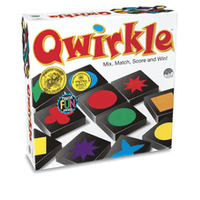Qwirkle
Qwirkle is a tile-based game for 2 to 4 players, designed by Susan McKinley Ross and published by MindWare. Qwirkle shares some characteristics with the games Rummikub and Scrabble. It is distributed in Canada by game and puzzle company, Outset Media. Qwirkle is considered by MindWare to be its most awarded game of all time.[1] In 2011, Qwirkle won the Spiel des Jahres, widely considered the most prestigious award in the board and card game industry. A sequel, Qwirkle Cubes, was released by Mindware in 2009.[2]
 The Qwirkle game box | |
| Publisher(s) | Mindware (Division of OTC Subsidiary of Berkshire Hathaway) |
|---|---|
| Publication date | 2006 |
| Genre(s) | Abstract, Family, Tile-laying |
| Players | 2-4 Players |
| Setup time | 1 minute |
| Playing time | 30–45 minutes |
| Random chance | Moderate |
| Age range | 6+ |
| Skill(s) required | Strategy, Logic |
Equipment
Qwirkle comes with 108 wooden tiles, and each tile is painted with one of 6 shapes (clover, four-point star, eight-point star, square, circle and diamond) in one of 6 colours (red, orange, yellow, green, blue and purple).[1] The box also contains a bag to store the tiles and a rule book.
Play
The game begins with all the tiles being placed in the bag and mixed thoroughly. Each player then randomly draws 6 tiles. During their turn, a player may either:
- place one or several tiles on the table; or
- instead of playing tiles, exchange one or more tiles in their hand for other random tiles.
In general, any tiles that are placed in a row must share one attribute (either color or shape), and they must be played in one line, although they do not need to touch other tiles being placed in that turn.
A player must always end a turn with 6 tiles, so, if they place tiles during a turn, they draw random tiles to build their hand back up to 6.
Play continues until one person uses all of their available tiles and there are no more tiles to be drawn.
Scoring
Players score 1 point for each tile placed within a line, including existing tiles within the line. The idea is to form lines that have each shape of a certain color, or each color of a certain shape. For example: if there are 3 stars placed down on the grid (1 green, 1 blue, and 1 purple), then the player can put down another star that is red, orange or yellow. If a line is completed (this is called a "qwirkle"), then an additional 6 points is added to the player's score.
At the end of the game, once there are no more tiles to be drawn to replenish one's hand, the first person to play all of their tiles gains an extra 6 point bonus, at which point the game ends, and the player who has the highest score wins.
Awards
- 2011 Spiel des Jahres
- Parent's Choice Gold Award
- Mensa Select Award
- Major Fun Award
References
- "Qwirkle: MindWare's Best-Selling Game of All Time". MindWare. 2012. Retrieved 3 June 2012.
- "Qwirkle Cubes 2009". BoardGameGeek. 2012. Retrieved 3 June 2012.